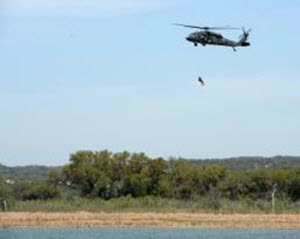Story by: Capt. Martha Nigrelle
Posted: October 29, 2015
 1st Lt. Alicia Lacy
1st Lt. Alicia Lacy
A Texas Army National Guard Sikorsky UH-60 Black Hawk hoists a member from the Federal Emergency Management Agency's Texas Task Force 1 during a search and rescue exercise at Canyon Lake, Texas, April 11, 2014. The joint, interagency exercise simulated emergency response following a hurricane, with members from the Texas Air National Guard, Texas Army National Guard, Texas Task Force 1, the U.S. Coast Guard and Texas Department of Public Safety integrating to form a joint response team. (U.S. Air National Guard photo by 2nd Lt. Alicia Lacy/ Released)
AUSTIN, Texas - After six days of fighting wildfires, Texas Army National Guardsman Sgt. Steven Nesbitt thought he was going home. Then the call came in – they were needed for floods.
“There’s not much to think about when the call comes in,” said Nesbitt, a helicopter crew chief and standardization instructor with the 36th Combat Aviation Brigade. “Just get your assets ready.”
Texas Guardsmen supported a total of seven wildfires in central Texas, Oct. 15-20, 2015, dropping more than 1 million gallons of water on the fires and saving hundreds of homes from destruction. As quickly as the fires had come, they were gone.
The day after the fires, it rained so much that several areas in Texas experienced flash flooding.
Switching gears from firefighting to swift water rescue operations, the same pilots and aircraft took to the skies, once again, to support local first responders and serve Texans in their time of need.
“The Department of Emergency Management calls us whenever the local and state resources are exhausted and need extra help, whether it be fire, floods or hurricanes,” said Col. Michael Dye, commander of the Austin Army Aviation Support Facility, Texas Army National Guard.
Defense support to civilian authorities is the official title the military uses when referring to this type of mission. Each National Guard unit has both a DSCA mission, working alongside local, state and federal partners to support domestic operations, and a combat mission.
Primarily, these guardsmen train to support Texans at home during wildfires, hurricanes and flash flooding, as well as, combat operations overseas; they even support the Department of Homeland Security with aerial interdiction along the Texas-Mexico border.
“We are constantly training throughout the year in order to remain proficient in these mission sets,” said Chief Warrant Officer 2 Christopher Cordero, a pilot for the 36th Combat Aviation Brigade. “So when we have an incident like we did, where we are fighting fires and the mission set changes and it’s time to go and respond to a flood event, we’re ready, that’s what we do.”
The combat aviation unit is equipped with several types of aircraft, UH-60 Blackhawks, CH-47 Chinooks, LUH-72 Lakotas and AH-64 Apaches, each with different capabilities, but each that can support a variety of missions.
“We bring a valuable dimension to the fire and search and rescue missions,” said Dye. “There are a lot of situations where ground crews cannot get to a location and the only way to get rescuers or fire suppression to an area is with aviation assets.”
Helicopter crews train regularly with first responders from the Texas A&M Forest Service and Texas Task Force One. The training the unit does with these and other partners helps prepare them for this diverse mission set.
“When the call came in to respond to the flooding, we just reset our aircraft,” said Cordero. “We removed the bucket we used to fight fires and our Task Force One partners came in and equipped the aircraft with their rescue basket, medical equipment and anything they needed to rescue individuals from rapidly rising water.”
Training and experienced helicopter crews work together to help mitigate the effects of natural disasters.
“My crews bring a high level of experience and dedication to mission accomplishment,” said Dye. “They have learned over the years to anticipate when events will occur and are prepared when the call comes in for support.”
And even though it doesn’t happen every year, crew members say battling different natural disasters back to back is not unheard of in Texas.
“In 2005, we were on the way home from fighting fires in the Davis Mountains, out in west Texas, and we got moved to respond to Hurricane Rita,” said Nesbitt. “Texas is a big state to protect – a lot of dry areas and a lot of wet areas.”
But regardless of what Mother Nature throws at Texas, the men and women of the 36th Combat Aviation Brigade say they are ready to support.
“We are strategically located throughout the state in order to respond to that DSCA mission, wherever it may be,” said Cordero.
Providing this support to local first responders and helping their fellow Texans is what drives most guardsmen said Nesbitt.
“That’s what motivates us,” he said. “Protecting the citizens of Texas.”